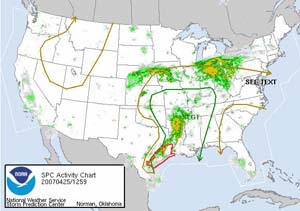| NOAA Magazine || NOAA Home Page |
SPRING STORMS BRING MIX OF SNOW, RAINS AND FLOODS, TORNADOES TO PLAINS STATES
 April
25, 2007 � A strong upper level system stalled over the southern High
Plains brought a variety of winter and spring severe weather to the
plains Tuesday. The storm dropped more than two feet of snow on portions
of Colorado while heavy rains caused flooding in much of Nebraska. The
NOAA Storm Prediction Center in
Norman, Okla., received nearly two dozen tornado reports from Colorado,
Kansas, Oklahoma and Texas. (Click NOAA image for larger view
of weather outlook for April 25, 2007, from the NOAA Storm Prediction
Center. Click here for latest
outlook. Please credit “NOAA.”)
April
25, 2007 � A strong upper level system stalled over the southern High
Plains brought a variety of winter and spring severe weather to the
plains Tuesday. The storm dropped more than two feet of snow on portions
of Colorado while heavy rains caused flooding in much of Nebraska. The
NOAA Storm Prediction Center in
Norman, Okla., received nearly two dozen tornado reports from Colorado,
Kansas, Oklahoma and Texas. (Click NOAA image for larger view
of weather outlook for April 25, 2007, from the NOAA Storm Prediction
Center. Click here for latest
outlook. Please credit “NOAA.”)
The most serious storm produced a tornado that touched down in Mexico then moved across the Rio Grande River into Eagle Pass, Texas, at about 7:01 p.m. CDT. Preliminary reports indicated six fatalities and 74 injuries from the tornado in Texas and three deaths and 40 injuries in Mexico.
In all, the NOAA Storm Prediction Center recorded three tornado reports in Texas, one in Oklahoma, six in Kansas and 13 in Colorado. The Kansas reports were a series of rope tornadoes that moved across northwest Reno County near Nickerson. The Colorado tornadoes were reported from early afternoon to late evening in Cheyenne, Kit Carson and Lincoln counties in the east-central part of the state. The single Oklahoma tornado was reported in Osage County in the northeastern part of the state. There were no early reports of injuries from the tornadoes in Colorado, Kansas and Oklahoma.
Wednesday morning, the NOAA National Weather Service forecast office in Boulder, Colo., canceled a winter storm warning and a snow and blowing snow advisory that had been in effect for north-central and northeastern Colorado. The forecast called for light rain and snow showers to end Wednesday morning.
Colorado Gov. Bill Ritter activated National Guard troops to help rescue motorists and school buses that had been stranded in deep snow. State officials closed numerous roads and officials in several areas planned to close schools on Wednesday.
The heaviest snowfall report received by the NOAA Boulder forecast office was 25.8 inches six miles southwest of Evergreen in Clear Creek County, Colo. Other reports included 24.6 inches 11 miles southwest of Boulder, 22.4 inches at Genesee in Jefferson County, 19.9 inches at Pinecliffe in Gilpin County and 12.7 inches 14 miles southeast of Aurora.
The Denver forecast calls for temperatures in the 50s Wednesday afternoon with a slight chance of afternoon thunderstorms and a high of 63 degrees on Thursday.
In Nebraska, many stream gauges along the Republic River were near or had exceeded flood stage. Much of the south-central and southeastern parts of the state were subject to flooding or flash flooding, according to NOAA forecasters at the Hastings weather forecast office.
More than 5 inches of rain was reported at Holdrege along U.S. Highway 34 in Phelps County, Neb., and there were unofficial reports of 5 inches and more in Kearney. The 2.68 inches of rain reported at Central Nebraska Regional Airport in Grand Island trounced the old record of 0.93 inches set in 1913. Other totals included 3.25 inches in McCook, 2.26 inches in Hastings, more than 2 inches in Lincoln and just short of 2 inches in Omaha.
NOAA's forecast for Wednesday calls for a possibility of severe thunderstorms from southeast and eastern Kansas across most of Missouri into southern Illinois and Indiana southward to include eastern Oklahoma and Texas, Arkansas, Louisiana and Mississippi to eastern Alabama, Tennessee and Kentucky.
NOAA, an agency of the U.S. Commerce Department, is celebrating 200 years of science and service to the nation. From the establishment of the Survey of the Coast in 1807 by Thomas Jefferson to the formation of the Weather Bureau and the Commission of Fish and Fisheries in the 1870s, much of America's scientific heritage is rooted in NOAA. NOAA is dedicated to enhancing economic security and national safety through the prediction and research of weather and climate-related events and information service delivery for transportation, and by providing environmental stewardship of the nation's coastal and marine resources. Through the emerging Global Earth Observation System of Systems (GEOSS), NOAA is working with its federal partners, more than 60 countries and the European Commission to develop a global monitoring network that is as integrated as the planet it observes, predicts and protects.
Relevant Web Sites
NOAA Hydrometeorological Prediction
Center
Media
Contact:
Patrick Slattery, NOAA
National Weather Service Central Region, (816) 268-3135